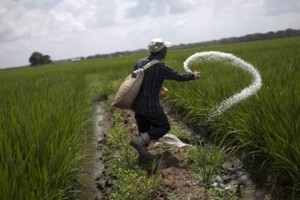These anomalies have cropped up because our policymakers are still stuck to the 1970s/80s thinking, geared towards increasing fertiliser usage
The huge arbitrage opportunity thereby created makes the temptation to divert too strong to resist and this can’t be reined in merely by neem coating; no administration, howsoever alert, can monitor a mammoth 600 million bags of urea.
The Modi government is in its sixth year, but a coherent policy continues to elude the fertiliser sector. To get a sense of how the central government is approaching the sector, and where the sector is headed, let us look at some crucial pronouncements by the prime minister.
First, in the 38th edition of his “Mann ki Baat” radio address to the nation (November 26, 2017), Modi exhorted farmers to take a pledge to halve their consumption of urea, which is the most widely used fertiliser, supplying nitrogen, or ‘N’, to plants, by 2022. At the same time, he has proclaimed, time and again, his commitment to reviving the ailing public sector fertiliser plants at Talcher, Gorakhpur, Sindri, etc. The two objectives seem contradictory.
If the first goal is achieved, the consumption of urea should decline from the approximately 30 million tonnes at present to 15 million tonnes by 2022. Against this, even if the current domestic production is maintained, at about 24 million tonnes, this will result in a surplus of 9 million tonnes if consumption is halved by 2022. Since the cost of Indian urea is significantly higher than the international price, exporting the surplus is not feasible; selling at a lower price will be tantamount to the importing country subsidising farmers its farmers, which won’t be WTO compliant. If, in addition to this, ailing plants are revived, what will the country do with the additional production?
Considering that diversion was at a significant 30%, its elimination ought to have resulted in a steep decline in subsidy payments. But, this has not happened; subsidy on urea was a high Rs 45,000 crore during FY19 against ~Rs 50,000 crore during FY15 (neem-coating was introduced in 2015-16). The allocation for FY20 is even higher, at Rs 57,000 crore.
Third, Modi wants soil health cards (SHCs) to encourage farmers to opt for a more balanced use of fertilisers based on soil analysis. But, pursuit of disjointed policies such as disproportionately high subsidy on urea—nearly 50%-75% of the cost is subsidised—vis-à-vis complex fertilisers (phosphate ‘P’ and potash ‘K’) only 25-30% of whose cost is subsidised and denial of secondary transportation costs for the complex fertilisers prompts farmers to use more urea. This, in turn, leads to imbalance in fertiliser use, and thereby militates against the objective of the SHCs.
Fourth, Modi has vowed to curb leakage of fertiliser subsidy by implementing direct benefit transfer (DBT). Yet, he continues with the existing unit-wise, new pricing scheme for urea, which protects high-cost units—we have units producing urea at the cost of Rs 20,000 per tonne as well as those producing urea at half this cost. Since the subsidy gets transferred to the bank account of the manufacturer after sale is authenticated by the farmer using his Aadhaar number, the authorities may prevent bogus claims, but excess payments to inefficient manufacturers continue.
Fifth, while the PM wants to give a boost to ‘Make in India’, the existing policy gives no incentive to companies to invest in exploration of indigenous resources, or in research & development for delivering more efficient and cost-effective products to farmers. For instance, at present, India depends heavily on import for meeting its fertiliser requirements—90% in P and 100% in K. As a result, even as the country remains vulnerable to exploitation by global suppliers, farmers don’t get any major breakthrough in yield because of skewed fertiliser use.
The root cause of these anomalies is that our policymakers remain glued to the antiquated framework of the 1970s and 1980s, which was designed solely to increase the production and consumption of fertilisers. In contrast, today, it is issues such as fertiliser use efficiency, balanced fertilisation, increase in crop yield, improvement in soil health, efficiency and cost optimisation in the supply chain, and reduction in subsidy that need greater attention. This is what Modi has himself repeatedly emphasised in his speeches.
The way forward is to unshackle the fertilisers sector from state controls, and leave all crucial decisions to market forces. Government intervention should be restricted to giving direct cash transfer subsidies to the poor farmers.
Left to market forces, urea’s MRP will increase to a level where its use is curtailed, leading to reduction in unbalanced fertiliser usage. By eliminating arbitrage, this will automatically eliminate diversion, too. Manufacturers will increase efficiency, and reduce costs. They will invest in R&D and innovation, and find more effective solutions to farmers’ needs. ‘Make in India’, too, will get a boost. Above all, the government will save a large amount on subsidy outgo. Will Modi bell the cat?
The author is Delhi-based policy analyst
http://epaper.financialexpress.com/2361915/Delhi/7th-October-2019#page/6/3
